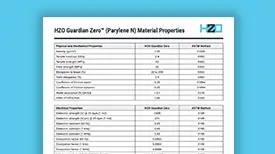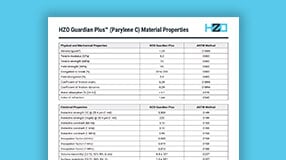IoT - Coating Consistency is Key

IoT sensors aggregate and send data to IoT dashboards, simplifying critical, complex decisions quickly. One key area where this is particularly true is the utilization of sensor data for predictive maintenance, a process that reduces downtime and lowers the total cost of ownership. Myriad other applications incorporate these “smart” sensors too.
Today, IoT sensors are ubiquitous, touching almost every aspect of life. Gas pressure sensors monitor pressure changes in oil, energy, and utility applications. Photoelectric devices (photo sensors) are now common in the consumer electronics vertical. Sensors are responsible for temperature monitoring, a typical use case for warehouse and inventory management, and HVAC systems monitoring.
Accelerometers detect subnormal industrial machine applications, while ultrasonic flow meters are coupled with IoT modules to send data about smart metering to a remote location. Moisture sensors have been critical in recent advances in smart farming, allowing for constant soil health monitoring. In the automotive sector, tunneling magnetoresistive sensors (TMR) are an increasingly popular way to measure mechanical displacement. And Particulate Matter sensors detect pollution in the industrial landscape and smart cities.
The chemical vapor deposition (CVD) process used to deposit Parylene conformal coatings can efficiently accommodate these complex surfaces. Parylene’s usefulness is primarily founded upon its ability to cover PCBA configurations with exposed internal surfaces, sharp edges, flat surfaces, points, and crevices with consistent coverage free of voids.

HZO PRO750 Parylene Coating Equipment
The Parylene Deposition Process – Consistent Coverage
Rather than dipping, spraying, or brushing pre-formulated layers onto PCBAs and other components, Parylene’s application method synthesizes the protective film in-process. This deposition system comprises a series of vacuum chambers that produce Parylene vapor, pyrolyze the vapor, then deposit the vapor as a polymer sequentially.
During the CVD process, gaseous Parylene penetrates the layers of a PCBA. Its vaporous consistency surrounds all areas as it builds coating protection along the exterior. The coating layers are substantially thinner than those provided by liquid conformal coating materials, enhancing reliability and functional versatility.
It has repeatedly been demonstrated that CVD is valuable for thin-film deposition on irregular PCBAs. CVD's Conformal layers are exceptionally uniform, even in the nanometer range. Because these coating layers are exceptionally thin, non-uniformity is minimal.
Reach out to an Expert
Choosing Parylene conformal coating services isn’t a failsafe decision, like anything else. Problems can occur with the process and the material. This is particularly true if the wrong Parylene type is used for a coating project while another type could provide better coverage. If you need a consultation to determine if Parylene is the right choice for your project, contact the HZO engineering team today, fill out a quote form, or leave a brief message.
Parylene Conformal Coatings - Parylene Conformality Explained
Parylene Coating Removal - Methods & Best Practices for Each
What is Parylene? Industry Use Cases, Types, Properties
Mallory is a veteran writer with over a decade of writing experience and has spent over five years at HZO learning about coating technology from the best minds in the industry. Professionally, Mallory is especially interested in the process of problem-solving and watching how the engineering team develops solutions that ensure business requirements are met. Over her years at HZO, Mallory's writing has been cited in industry whitepapers, including "Parabolic Model for Optimum Dry Film Thickness (DFT) of Corrosion Protective Coatings" and "Universal Approach to Integrating Reduced Graphene Oxide into Polymer Electronics." All of Mallory’s blogs are reviewed for accuracy before publication.
Additional Resources

Learn About Parylene Properties With Our Resource Page

Learn How To Incorporate Conformal Coating Into Your Manufacturing Process

Learn About the Thin Film Coating Properties and Processes In Our Webinar

Learn How to Bring Parylene Deposition In-House





















